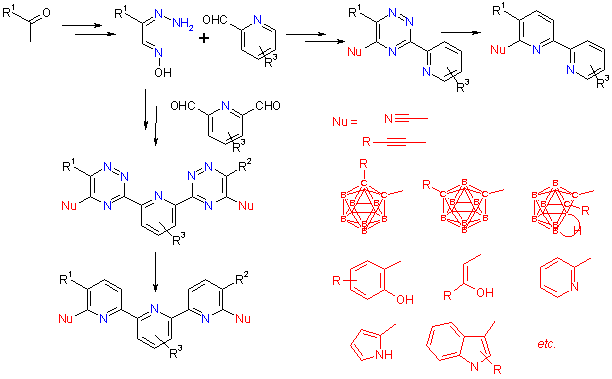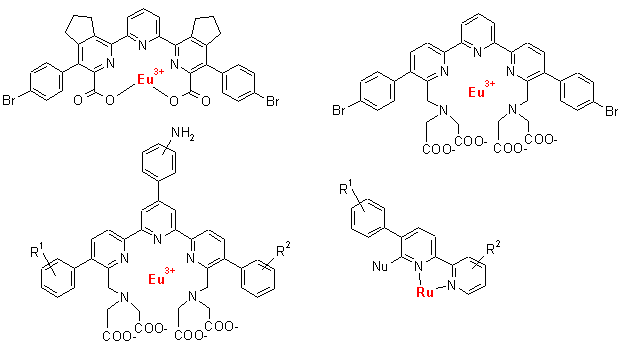Research
We
are interested in all aspects of heterocyclic chemistry, particularly in studies of new approaches for synthesis of functionalized
compounds with target properties. Much of our work is based on the use of
heterocyclic ligands for synthesis of transition metal complexes for different
applications.
New
synthetic methodolog es
We
study new methods for the synthesis and structural modification of azaaromatics,
in particular pyridines, pyrimidines, pyrazines and 1,2,4-triazines. Special
attention we pay to chemistry of 1,2,4-triazines due to their high reactivity
towards nucleophiles and relatively easy transformation into other heterocycles
(e.g. pyridines).
One of our strategies includes four main steps. The first one is a
construction of the 1,2,4-triazine ring bearing various (hetero)aryl and/or
alkyl substituents. The second step is the direct introduction of a new
functional groups into 1,2,4-triazine ring through reactions of aromatic
nucleophilic substitution. The third step is a transformation of new
1,2,4-triazines into pyridines via aza-Diels-Alder reactions with retention of
all substituents in a new heterocycle. The last step is a chemical modification of
these substituents by usual manner.

Such approach allows easy and flexible synthesis of a great variety of
new compounds for several purposes.
Applications
of new compounds
We
make an emphasis on two general applications of new heterocycles: new
functionalized ligands for transition metals, and collecting libraries of
original compounds for biological screening.
New
ligands
Our
synthetic strategy was found to be effective for the synthesis of functionalized
polypyridines (bipyridines, terpyridines, their aza-analogs) ¢ one of the
widely used class of ligands. Distinguishing feature of the method is relatively
easy and flexible modification of polypyridines providing fine tuning of the
desired properties.

We are aimed to obtain new complex compounds of transition metals and new
ligands with interesting photo-physical properties (e.g. room temperature
fluorescence), magnetic properties, catalytic activity (including asymmetric
homogeneous catalysis), self-assembly etc. In particular we pay great attention
to the synthesis of Eu and Ru complexes of new ligands with good luminescent
properties (intensity, quantum yields, life-time).

Crystallographic
structure of ligands and complexes you can see here.
Biological
active compounds
All
synthesized heterocyclic compounds are interesting as biological active
compounds. We collected library of 1,2,4-triazines, pyrimidines, pyrazines and
pyridines. This amount can be extended due to easy methods for synthesis
(available for parallel liquid phase synthesis) and a library of
building-blocks. 1000 topic structures can be downloaded
as ISISTM/Base
file.
Examples of
1,2,4-triazines

|